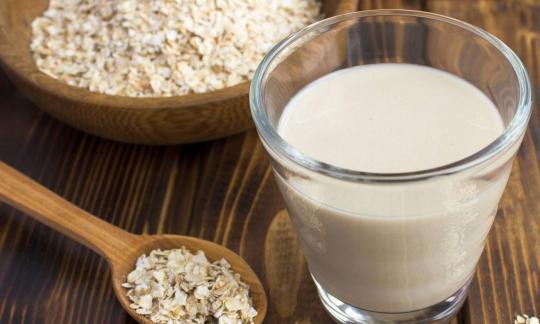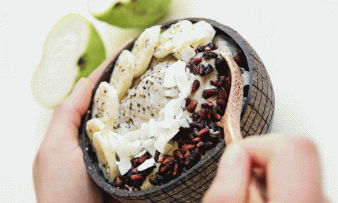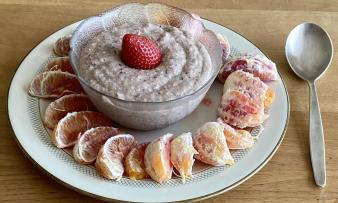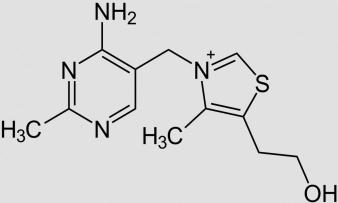Table of contents
Oat milk (EU: oat drink) is made from ground seed oats ( Avena sativa) or from oat flakes. This purely plant-based cereal milk is a healthy, lactose-free milk substitute, although it is very rarely raw.
Use in the kitchen
The slightly sweet, mild grain-like tasting oat milk is used in cold and (lukewarm) warm dishes. Vegans, ovo-vegetarians and people with lactose intolerance in particular enjoy using this grain drink. If you completely avoid heating it during any of the production steps, you can consider oat milk to be a raw food. This is very rarely the case (see also below under "Your own preparation").
The taste is more neutral than almond milk or soy milk ; rice milk tastes even sweeter.
Oat drink is suitable for muesli, porridge, semolina pudding, rice pudding and smoothies as well as for making pancakes or other sweet dishes. But savory dishes such as potato gratin or vegetable casserole can also be refined with a béchamel sauce made from oat milk.
Oat milk can also be frothed well, so baristas also like it for a successful cappuccino.
Oat milk can be processed into products such as oat cream (Oat Cuisine), crème fraîche substitute (=Oat Cuisine Fraiche) or spread.
Homemade preparation
You can also make your own raw, unheated and unprocessed oat milk. Be careful: this unheated oat milk is only really raw if you work with raw food quality oat flakes. Raw oat flakes are pretty hard to get hold of, because the oat flakes sold in stores are almost always dried (heated) to increase their shelf life. Even if the sales staff claim otherwise, these oat flakes are not raw. If you want to find out more, read the ingredients text Oat flakes (raw?, organic?).
For one liter of oat milk or oat drink you need 80-120 g of whole grain oat flakes (raw and organic if possible), one liter of drinking water, a good blender (stand mixer or hand blender), a suitable container and a filter (fine-mesh sieve, strainer or nut milk bag).
Preparation:
- Soaking (optional) : The first step is to soak the oat flakes in enough water to make blending easier. The soaking time can be between 3 and 12 hours (overnight). The longer you soak the flakes, the easier the subsequent processing will be. If you have a powerful blender, you can skip this step.
- Mixing : Either sieve the soaked oat flakes and put them in the blender with fresh water, or use the soaking water directly. To begin with, only add a portion of the water. Then chop the flakes well in the blender and gradually add more water.
- Filtration (optional) : If you have a good blender and small oat residues don't bother you, you can pour the oat drink directly into the container. Otherwise, use a filter of your choice. However, very "fine-meshed" filters will reduce the taste somewhat.
- Filling and storing : Pour the oat drink into a glass container and seal it tightly. The oat drink will last for 3-4 days in the fridge.
Notes : If you skip the soaking step, you can make the oat drink fresh each time (in smaller portions). To sweeten it and improve the taste, you can add pitted dates (3-5 pieces), vanilla or cinnamon powder directly during the mixing process.
Vegan recipe for béchamel sauce made from oat milk
Ingredients: 100 g margarine, 4 tbsp wheat flour, 1 L oat milk (organic), salt,pepper, grated nutmeg.
Preparation: Melt the margarine in a saucepan, add the flour and stir well for a few seconds until the fat and flour are well mixed. Pour in some of the plant milk and simmer, stirring constantly. Keep adding a little milk until the roux is well combined with the milk. You can reduce the heat a little. After you have added all the oat milk and the sauce has thickened, season with salt, freshly ground pepper and grated nutmeg.
Vegan recipe for berry smoothie with oat milk
Wash 2 handfuls of berries (e.g. mulberries, blueberries) well, remove the stems and mix finely with 250 ml of oat milk. Pour into glasses and enjoy.
Vegan recipes with oat milk ( oat drink) can be found under the note: " Recipes that have the most of this ingredient ".
| Not only vegans or vegetarians should read this: Vegans often eat unhealthily. Avoidable nutritional errors. |
Purchasing - Storage
Oat milk and oat drinks are now available in all supermarket chains such as Coop, Migros, Denner, Volg, Spar, Aldi, Lidl, Rewe, Edeka, Billa, Hofer etc. Most supermarkets also have organically certified oat milk in their range. This can also be found in health food stores, drugstores, organic shops and organic supermarkets ( Denn's Biomarkt, Alnatura) - and of course in online shops. Oat drinks are usually available in natural, calcium, vanilla or chocolate flavor. Some are also available mixed, e.g. with almond flavor.
The question " Which oat milk is good?" is not easy to answer, as there are so many to choose from. It is best to try out different milk substitute products and decide based on taste. We recommend looking for organic quality and few additives.
Organic oat milk sometimes contains calcium from the calcium-rich seaweed Lithothamnium calcareum, while conventional oat milk is often enriched with calcium carbonate.
The term "milk" is a colloquial term because it is a milk substitute. In the EU, only the terms oat drink or oat beverage are used because the term milk is no longer permitted ( "milk" is reserved exclusively for the product of normal udder secretion obtained by one or more milkings, without any addition or removal.) 1
The availability of oat milk varies depending on the size of the store, catchment area, etc. Our recorded food prices for the DA-CH countries can be found above under the ingredient image - and by clicking you can see their development at various suppliers.
Storage tips
Purchased oat drinks are usually heated to ultra-high temperatures and therefore last for several months unopened. After opening, however, they should be stored in the refrigerator like a fresh product and consumed within a few days. Plant milk should always be shaken well before use so that the sedimentary solids are evenly distributed.
Ingredients - Nutritional values - Calories
Oat milk contains 39 kcal per 100 g. The fat content is very low at 1.4%, as is the protein content at 0.6%. Carbohydrates make up around 6.3%.
Oat milk does not have a particularly high proportion of essential nutrients. Manganese is not very well represented at 0.3 mg/100g; similar values are found in corn semolina, raisins and wild garlic. As a trace element, manganese is important for the development of healthy cartilage tissue 2. Vegans often meet their manganese requirements with seeds and nuts, but also with oat flakes (3.6 mg/100g).
Oat milk does not naturally contain a lot of calcium. We have compiled ingredients that contain a lot of calcium for you here.
B vitamins are present in oat milk, but not in abundance: for example, the water-soluble thiamine (vitamin B1) at 0.1 mg/100 g. Hazelnut milk and rice syrup have similar values, and significantly more of it is found in linseed (1.6 mg). This B vitamin is mainly found in the outer layers of grains and is responsible for energy metabolism and the nervous system. 2 Vitamin B6 (pyridoxine) is also present in oat milk at 0.1 mg/100g, similar to coconut flour and panko. Amaranth, for example, has much more (0.59 mg). Vitamin B6 is involved in many enzymatic reactions and plays an important role in protein metabolism. 2
There is significantly less of other vitamins such as vitamin K and vitamin E.
Oat milk also contains sodium, phosphorus, magnesium and iron in small amounts.
The complete ingredients of oat milk, the coverage of the daily requirement and comparison values with other ingredients can be found in our nutrient tables. In the article Nutrients explained you will get a detailed insight into the topic.
Health effects
How healthy is oat milk? Oat milk is very popular with people with lactose intolerance, milk protein allergies or soy allergies. For vegans and ovo-vegetarians, it is a common substitute for cow's milk.
The beta-glucans (insolublefiber) contained in oats reduce the cholesterol level in the blood because they bind the bile acids and cholesterol in the intestine. In addition, these fibers bind a large amount of water due to their high swelling capacity, which promotes digestion and strengthens the immune system. The complex carbohydrates regulate and normalize blood sugar levels and improve the feeling of satiety. 3
Secondary plant substances
Many of the health effects of oat milk can be attributed to the secondary plant substances contained in oats. Our article on secondary plant substances provides an overview of the classification of substance groups, their occurrence in foods and possible effects on humans. Oats contain the following secondary plant substances, among others: 11,12,13
- Isoprenoids: Triterpenes: Sterols (Delta-5-Avenasterol, Delta-7-Avenasterol,Beta-Sitosterol), Saponins (Avenacoside A, Avenacoside B)
- Polyphenols: Phenolamides: Avenanthramides (Avenanthramide A, Avenanthramide B, Avenanthramide C); Phenolic acids: Hydroxybenzoic acids (Protocatechuic acid, Syringic acid, 4-hydroxybenzoic acid, Gallic acid, Vanillic acid); Hydroxycinnamic acids (Ferulic acid, o-coumaric acid, p-coumaric acid, Caffeic acid, Sinapic acid); Flavonoids: Glycoside flavonoids (Linarin, Tilianin); Flavonols (Kaempferol, Quercetin, Myricitrin, Quercitrin, Rutin); Flavones (Tricin, Luteolin, Apigenin)
However, it should be noted that the composition of secondary plant substances in oats and products made from them can vary depending on the variety, time of harvest, growing conditions, recipe and manufacturing process. Therefore, quantities are only of limited use and should only be understood roughly.
Oats, the basis of oat milk, contain numerous bioactive substances that can help prevent cancer, high cholesterol, diabetes and cardiovascular disease. In a study examining the risk of chronic kidney disease and kidney stones from consuming plant-based milk, oat milk showed the lowest risk of kidney stones compared to almond milk and cashew milk and also outperformed cow's milk. Another analysis shows the effect of oat milk consumption on blood lipids and antioxidant capacity. After four weeks of daily consumption of 0.75–1 liter of oat milk, plasma cholesterol levels dropped significantly compared to consuming cow's milk, while antioxidant capacity increased. 11
Avenanthramides are found only in certain plants, especially oats, the basic ingredient in oat milk. These phenolic compounds have been shown to have anti-inflammatory, antihypertensive and antitumor properties in in vitro and in vivo studies. 11,12 In a human study, administration of these polyphenols increased antioxidant biomarkers. In rats, avenanthramides increased antioxidant defense enzymes. In hamsters, they prevented the oxidation of LDL cholesterol in the blood, which may help prevent cardiovascular disease. 13
Dangers - Intolerances - Side effects
Oats are not gluten-free, but some adult celiacs tolerate the gluten protein "avenin" better. Most oat products are contaminated with grains containing gluten (wheat, barley, spelt), which does not have to be labeled according to food law. There are gluten-free oats (gf oats) in which the contamination is less than 20 ppm, but avenin is contained in normal quantities. If you have no problems with this, you can rely on the gluten-free symbol, the crossed-out ear of corn. However, each person has to test out for themselves whether they can tolerate avenin, under medical supervision. 4
Industrial oat milk is almost always ultra-heat treated to ensure a longer shelf life. It is often sweetened, with calcium, emulsifiers, stabilizers or other additives added. Oat milk is almost always enriched with sunflower oil and in 2019 Öko-test found products that contained phosphates.
To make sure that there are no unnecessary additives, it is best to make the drink yourself.
Ecological footprint - animal welfare
Plant milk is not only a good alternative to animal milk in terms of health, it is also much more environmentally friendly and of course gentler on animals. Oat milk in particular has a good ecological footprint if you assume that it is grown and processed locally (and the associated shorter transport routes). Even if the land use for oat milk is slightly higher than that of other plant-based drinks, the fresh water consumption (around 48 liters per 1 L of oat milk) is significantly smaller than almond milk (approx. 371 liters) or rice milk (270 liters), let alone cow's milk (628 liters). 8 In terms of other factors such as the eutrophication potential of freshwater and aquatic systems and toxicity to terrestrial and freshwater habitats, oat milk also has the smallest impact compared to other plant-based drinks. Compared to cow's milk, however, all plant-based drinks perform better. 9
Figures for Germany show that the production of oat milk has a CO 2 footprint of 0.3 kg CO 2 eq/kg, and that of cow's milk it is 1.4 kg CO 2 eq/kg. 10 Figures collected for global comparisons may vary. 8.9
In Europe, oats are often found in organic quality, where no synthetic pesticides or chemicals are used. This is particularly gentler for pollinating insects, but also for the ecosystem in general. The Swedish company Oatly commissioned the Swedish Institute of Food and Biotechnology ( SIK) to conduct a study on the ecological balance. The result: oat milk has around 70% less harmful effects on the climate and uses less energy (around 40%) than semi-skimmed cow's milk. In addition, around 80% less land is required. 7
For detailed explanations of various sustainability indicators (such as ecological footprint, CO2 footprint, water footprint), see our article: What does the ecological footprint mean?
Worldwide occurrence - cultivation
Since the 1990s, there has been a method of producing oat drinks. This method was developed by the Swedish professor Rickard Öste at the University of Lund. Issues such as lactose intolerance and organic farming led to this development; together with his brother Björn, he founded the company Oatly. 5
Industrial production
In order to be able to process the oat grains further, they have to be dehusked. In industrial production, the grains are mixed with water and ground very finely. Fermentation is sometimes used. The mass is then homogenized and the solid components are filtered out. These filter residues (e.g. bran) can still be used for consumption or animal feed. Vegetable oil emulsifies the watery extract and the drink takes on a typical milky color. Sweeteners, table salt and other flavors are added depending on taste. Other preservatives, thickeners, acidifiers, vitamins (e.g. B12) and minerals (calcium) are also used here. Ultra-high heating completes the process and the oat milk can be kept for a long time even without refrigeration. 6
Further information
Other plant-based drinks that are used in the kitchen as milk substitutes (milk substitutes, plant-based alternatives) are the three well-known ones: almond milk, rice milk and soy milk. But tasty drinks can also be made from hazelnuts, coconut meat, hemp seeds, millet, lupins or peas (yellow split peas).
Which milk substitute is healthiest? For many, oat milk is the best milk substitute in terms of taste and sustainability.
Alternative names
Oat milk is also known as oat drink or oat beverage. In English it is called oatmilk; milked oats is also possible, but this is a registered trademark of Elmhurst.
Bibliography - 13 Sources
| 1. | Amtsblatt der Europäischen Union. Verordnung (EU) Nr. 1308/2013 des Europäischen Parlaments und des Rates vom 17. Dezember 2013. Teil III Milch und Milcherzeugnisse, 207. |
| 2. | USDA United States Department of Agriculture. |
| 3. | Fachgesellschaft für Ernährungstherapie und Prävention. Beta-Glucane - Ballaststoffe mit besonderen Wirkungen. 2017. |
| 4. | IG Zöliakie der Deutschen Schweiz. Hafer in der glutenfreien Ernährung. Juni 2018. |
| 5. | Oatly.com The oatly way. |
| 6. | Mäkinen OE, Wanhalinna V et al. Foods for Special Dietary Needs: Non-dairy Plant-based Milk Substitutes and Fermented Dairy-type Products. Critical Reviews in Food Science and Nutrition. 2015;56(3):339–349. |
| 7. | Albert-Schweitzer-Stiftung. Ökobilanz Pflanzenmilch. |
| 8. | Ritchie H. Dairy vs. plant-based milk: what are the environmental impacts? Our World in Data. 2022. |
| 9. | Geburt K, Albrecht EH et al. A Comparative Analysis of Plant-Based Milk Alternatives Part 2: Environmental Impacts. Sustainability. 2022;14(14):8424. |
| 10. | Reinhardt G, Gärtner S, Wagner T. Ökologische Fussabdrücke von Lebensmitteln und Gerichten in Deutschland. Institut für Energie - und Umweltforschung Heidelberg. 2020. |
| 11. | Yu Y, Xinping L et al. Oat milk analogue versus traditional milk: Comprehensive evaluation of scientific evidence for processing techniques and health effects. Food Chemistry: X. 2023;19:100859. |
| 12. | Cui L, Jia Q et al. A comprehensive review on oat milk: from oat nutrients and phytochemicals to its processing technologies, product features, and potential applications. Food Funct. 2023;14(13):5858–5869. |
| 13. | Chen CYO, Milbury PE et al. Avenanthramides are bioavailable and have antioxidant activity in humans after acute consumption of an enriched mixture from oats. The Journal of Nutrition. 2007;137(6):1375–1382. |













Comments